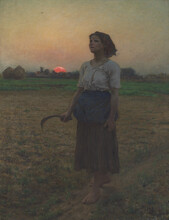· 5 min read
Exhibit focuses on Cather’s imagination

Visitors to the Sheldon Museum of Art will have the opportunity to walk in Willa Cather’s footsteps and take in works of art that inspired her narratives of sweeping vistas that made her novels famous.
“Visual Cather: The Writer’s Pictorial Imagination” opens May 19 at the Sheldon Museum of Art, 12th and R streets, and will run through Aug. 30. The new exhibition is co-sponsored by the Cather Project of the University of Nebraska-Lincoln and was curated by Lindsay Andrews, a graduate student of English, and Ashley Hussman, associate curator at the Sheldon.
The exhibit’s centerpiece is a popular 19th-century painting that directly inspired Cather’s “The Song of the Lark,” a significant novel that is celebrating its 100th anniversary of publication this year. The painting, also titled “The Song of the Lark,” by Jules Breton, is on loan from the Art Institute of Chicago.
Andrews, who has studied Cather’s novels and specializes in visual and material culture, said the Breton painting is breathtaking and will draw in visitors.
“It’s such a magnetic, beautiful painting anchored by the peasant girl in the foreground and set aglow by a luminous sunset,” she said. “It’s certainly the centerpiece of the exhibition, and Ashley and I decided that it would be best to give that painting a rule of importance. It’s in the dominant sightline as you walk into the doors of the gallery.”
The exhibit will take visitors on a journey through Cather’s career, starting with the art she likely encountered as a student at the University of Nebraska. Cather was known to enjoy both visual and performing arts, often including references to works in her short stories and novels.
“The exhibition celebrates Cather’s maturation as a writer and her craft as an artist, beginning with her time as a student in Nebraska, followed by her European travels, where she acquired her taste for European art and further developed her skill of descriptive writing as she saw more of the world,” Andrews said.
Another wall posits that Cather’s authorship was its own kind of artistry. Works there include sketches from artist W.T. Benda, whom Cather commissioned to illustrate key scenes in “My Antonia,” and copies of the novel “The Song of the Lark,” whose covers were emblazoned with the Breton painting during its early publication.
“Cather wasn’t a painter in the literal sense, but her rhetoric and her editorial finesse affirm her artistry,” Andrews said. “I can read a passage and think I’ve seen that painting before. It’s the way that she narratively constructs her richly detailed descriptions of the Plains.”
The exhibit wraps up with a wall of Cather portraits, or “Cather as subject,” where her likeness inspired artists.
Andrews spent time researching the art Cather wrote about and delved into the history of the University of Nebraska. She found there were several important artists in Nebraska when Cather attended the university, including Cora Parker, head of the art teaching staff when Cather was a student.
“If I can’t display work that Cather saw specifically, we’re using something as close to it as possible,” Andrews said. “They are the types of works that Cather saw and admired.”
Most of the artwork was pulled from the Sheldon archives. Other pieces are on loan from UNL’s Archives and Special Collections, Omaha Public Library, the Willa Cather Foundation and the Willa Cather Pioneer Memorial Collection of the Nebraska State Historical Society.
Guy Reynolds, professor of English and director of the Cather Project, said the exhibit is fortunate to have the Breton painting because it inspired a groundbreaking novel that served as a springboard to the rest of Cather’s career.
“ ‘The Song of the Lark’ was one of the first major American novels about a female artist,” Reynolds said. “Cather also was interested in her own growth as an artist, and the novel sketches out a completely new terrain for Cather — a subject that she returns to over her entire career. It has iconic significance in her work. It’s a moment when you glimpse part of a bigger, broader world than the one you’ve grown up in and that’s important in Cather’s work — a sense of opportunity.”
The exhibit coincides with UNL serving as co-host to the 15th International Willa Cather Seminar June 5-11. The seminar also focuses on Cather and the arts. Along with the exhibit, the Sheldon will host several events, which are free and open to the public. For more information, go to http://www.sheldonartmuseum.org.
The gallery events are:
May 19, 5:30 p.m. — ”Two Nebraskans: Willa Cather and Robert Henri,” a joint gallery talk by Lindsay Andrews, co-curator of “Visual Cather,” and Jonathan Frederick Walz, Sheldon’s curator of American art
June 11, 3 and 4 p.m. — “Visual Cather” gallery talks presented by Andrews, followed by a reception
July 14, 5:30 p.m. — Willa Cather at UNL Talk and Walking Tour, a walking tour of Cather-related sites on the UNL campus after a brief talk in the gallery presented by Andrews
July 19, 1 to 4 p.m. — Family Day, an afternoon of art-making activities, ice cream and fun for all ages








